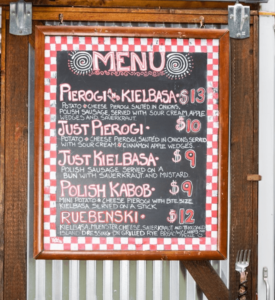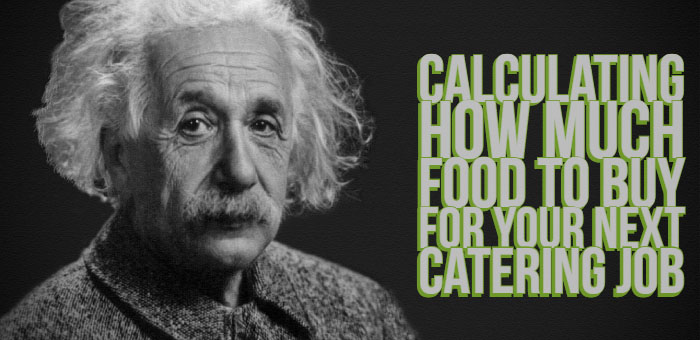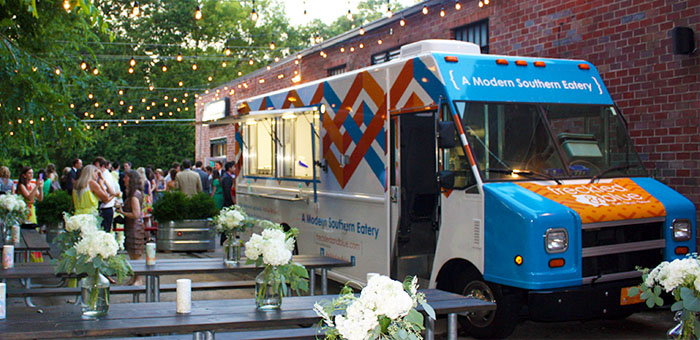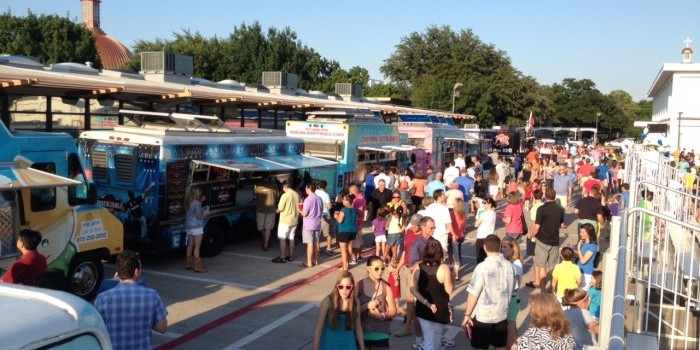Catering for holiday parties, birthdays, weddings, anniversaries and community events generate great opportunities for mobile food vendors to grow their business. Food truck catering offers opportunities for attracting new customers, extending your reach into your community and increasing profits, but vendors also face some challenges as well.
Food truck catering involves some different skill sets than your everyday food truck staff members normally use. These include greater people skills, planning and different menu execution. Here’s how to identify and adjust to these challenges before you get to an event. I learned a lot of these lessons the hard way, but you don’t have to.
Page Contents
Different Types Of Catering
Food truck catering can consist of the simple packaging of your truck’s standard menu or include special party platters, custom menus, food deliveries and custom off-site menus for private parties. Simple carryout packaging of regular menu items is the easiest way for a food truck vendor to cater, and handling private parties at an event venue using the regular menu is only a bit more difficult.
- Creating a catering menu that extends the regular menu without disrupting regular operations.
- Off-site catering generates the greatest challenges to produce successful events while keeping regular restaurant service at its usual level of quality.
- Choosing one or more staff members to communicate with catering customers and coordinate bookings and service can help to facilitate handling inquiries, but someone on duty should always be available to talk to prospective customers.
Catering On-site or Off-site
Off-site catering (jobs where you cook your menu at your commercial kitchen and end up bringing the food to the venue) generates some unique challenges. Planners must choose foods carefully because some dishes don’t travel well or hold up in chafing dishes. Some foods dry out, and others only taste best in those narrow periods when foods are perfectly cooked.
- Seafood items become overcooked in chafing dishes and produce unappetizing smells when held. Always try to grill fish at the venue to order.
- Fried foods become cold, greasy and soggy. Fry food on-site for best results.
- Pastas dry out or become overcooked when held in chafing dishes for very long. Try casserole dishes, or boil pasta and add sauces on-site just before service.
- Red meats grow cold if they rest too long and overcook if held in heated pans. Try cooking meats slightly underdone and let chafing dishes finish the process. Another option is to grill meats at the site.
Soups and chili, salads, fruit dishes, and braised foods work well for catering menus. Chicken dishes reheat well, and raw oysters are fantastic appetizers that are perfect for travel. Also consider creating a boxed lunch package for corporate lunches.
Space and Setup Limitations
Tight Spaces
Many event venues are not designed with food trucks in mind. Whether it’s a quaint backyard wedding, a corporate event in a parking lot, or a community event at a local park, the allocated space can sometimes be surprisingly restrictive. Operating in a tight space means we must be incredibly efficient with our setup. It’s not just about fitting the truck into the space; it’s about ensuring there’s enough room for our staff to move around safely, for guests to form a line, and for the service to flow smoothly without creating bottlenecks.
Uneven Surfaces
Uneven surfaces present a unique set of challenges. Our food trucks are essentially mobile kitchens, and kitchens require stability. Operating on a slope or uneven ground can affect the functioning of our equipment, from refrigeration units to fryers and grills. It can also pose safety risks for our staff working inside the truck. To mitigate these risks, we often have to bring along additional equipment like leveling blocks or mats, which adds to the complexity of our setup.
Lack of Access to Necessary Utilities
Perhaps one of the most significant challenges is the lack of access to necessary utilities like electricity and water. While our trucks are designed to be self-sufficient to a degree, certain events require more power or water than our onboard systems can provide. For example, if we’re serving dishes that require significant prep work or keeping large quantities of food warm over extended periods, we might need to plug into an external power source. Similarly, events where we’re serving hundreds of guests necessitate more water for cooking and cleaning than our tanks hold.
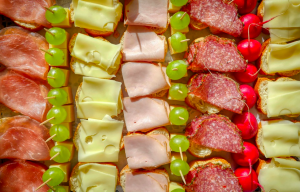
Cold cuts for a catering event.
To navigate these challenges, planning and communication are key. We conduct site visits whenever possible, communicate closely with event organizers, and develop contingency plans for power and water. We’ve learned to be adaptable, using our experience to anticipate issues and solve problems on the fly.
Special Diets for Event Guests
As a seasoned food truck owner, I’ve witnessed firsthand the evolution of consumer expectations and demands, particularly when it comes to accommodating special diets. What once was an occasional request for vegetarian or low-calorie options has burgeoned into a complex array of dietary needs, including gluten-free, vegan, keto, paleo, and allergen-free meals, among others. Navigating this landscape is not just about diversifying the menu—it’s about ensuring the health and safety of our guests.
Understanding and Educating on Special Diets
The challenge begins with education. I have spent countless hours researching and training to understand the nuances of these diets. For instance, distinguishing between a preference for gluten-free and a medical need due to celiac disease is crucial. The former might be more forgiving of cross-contamination risks, while the latter requires strict adherence to food safety protocols to avoid triggering severe health reactions.
It’s not just about removing a problematic ingredient from a dish, it’s understanding how every component of a meal is prepared. This includes scrutinizing our suppliers, ensuring that there’s no cross-contamination at any point in the food preparation process, and even reevaluating our kitchen layout and equipment to prevent mix-ups.
Menu Planning and Communication for Special Diets
Designing a menu that accommodates special diets you’ll want to limit yourself to 1 or 2 options max in my opinion.
Clear communication with our customers is also vital. Our menus must accurately describe each dish, highlighting which dietary needs they meet. This transparency extends to our interactions with customers, whether it’s in person, over the phone, or through our online presence.
As part of this communication process, explain to customers that adding specialty items will change the estimates when you’re calculating the cost of the catering event. When you add specialty items it increases labor and often the ingredients cost a lot more if your want organic produce or harder to find ingredients. Explain this to your catering clients and let them decide on how to proceed.
Pricing and Planning for Food Truck Catering
Regardless of format, your staff will need access to basic equipment such as ovens, griddles, fryers, holding cabinets, steamers, refrigeration, and hot boxes to transport foods at safe temperatures.
- Clear communications and careful scheduling prevent overworking your regular truck employees and risking a lack of staffing at a big catering gig.
- Planning menu prices involves adding extra expenses such as delivery costs, mileage, equipment wear and tear and insurance.
- Don’t take on projects that are too large for your truck or staff to handle.
- Tiered pricing is a strategy that drops the cost per person as guest counts rise.
- Custom pricing analyzes each project by its unique criteria to determine the price for each customer.
- Fixed prices charge set prices for certain quantities of each dish. Prices might also charge by the head count.
- Extra fees might include cake-cutting fees, delivery fees, server fees and set-up or take-down fees.


